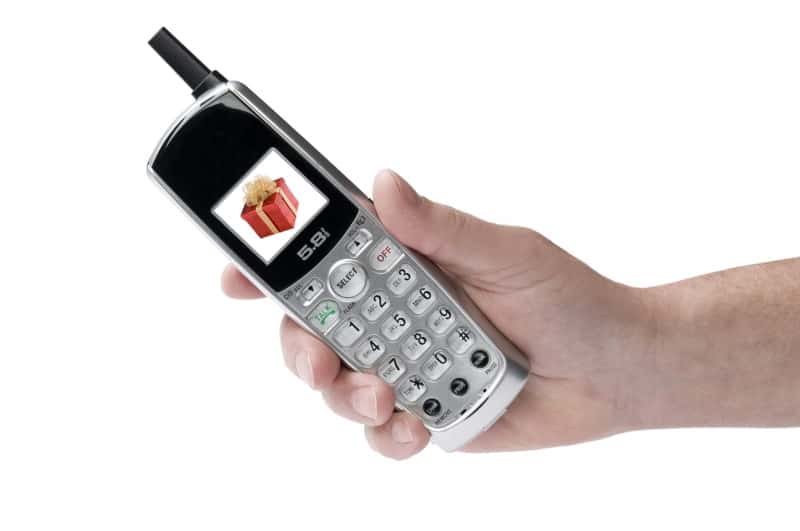Do cordless phones interfere with Wi-Fi? According to Epitiro, a study done by a UK broadband analysis firm shows that customers reported 30% loss on broadband data speed when they connected to Wi-Fi network radio signals.
Cordless phones operate on a 2.4 GHz radio spectrum used by Wi-Fi standard 802.11b wireless networks. When equipment shares the same frequency band, each of the units may interfere with each other. As a result, it slows down the Wi-Fi connection signals. The level of interference depends on how the cordless phone operates.
Some household appliances such as cordless phones, baby monitors, and microwave ovens do interfere with the performance of Wi-Fi networks. Most Wi-Fi equipment uses the overcrowded 2.4 GHz band to transmit signals. Therefore, if you use a 2.4 GHz router, chances are your neighbors are using the same broadband. The Wi-Fi network from their router will interfere with your own network. As a result, the performance of your own network will be hindered, and your wireless network range will be reduced.
Wi-Fi signals can also generate interference that affects the operation of your cordless phone and interferes with the quality of calls made via the phone. Therefore it is not only the cordless phones that affect the performance of Wi-Fi signals. Having a Wi-Fi router next to your cordless phone will reduce the voice quality in your phone.
This problem occurs most often when the cordless phone and the Wi-Fi router are operating at the same radio frequency. If the phone base station and the Wif-Fi router both operate at 2.4 GHz, they’re likely to interfere with each other.
How the Cordless Phone Impacts the Wi-Fi Network
If you switch on your cordless phone, it transmits a 10 MHz signal via the 2.4 GHz frequency band regardless of whether it has a dial tone or not. The 2.4 GHz band has a signal bandwidth of about 90 MHz.
If you turn on another phone, it will also generate a 10 MHz bandwidth signal. The phone will search for the least congested frequency and channel its transmitter to that frequency. This trend continues for any other cordless phone switched on.
Depending on the operation of the phones, they reduce the capacity to support the Wi-Fi signals. If you have six cordless phones, they will end-up occupying at least two thirds of the spectrum band.
It is interesting to note that Wi-Fi access points only use a third of the spectrum band. If you have 7 cordless phones, they will fill up the remaining spectrum space, and there will be no room for more phones. If you introduce more phones in the access point, it will result in an interference between the Wi-Fi access point and the cordless phones.
As a result, you will have a distorted voice when talking to someone over the phone. It also increases frame retransmission rate via the access points.
This means that before deploying your Wi-Fi network in a particular area, you have to test the number of cordless phones in the surrounding area.
Different types and models of cordless phones operate differently. Some of them use a frequency hopping spread spectrum that is capable of distributing radio frequency (RF) signals across the entire 2.4 GHz frequency band. In this system there are no Wi-Fi access points left.
The interference not only affects the cordless phones, but also it slows down the speed of data transmission via the Wi-Fi access points.
How to Avoid This Problem
1. Use Dual Band
Buying a dual-band router that operates between 2.4 GHz and 5 GHz will help solve the problem. The 5 GHz band is not as congested as the 2.4 GHz. The older Wi-Fi devices rely on the 2.4 GHz band while the newer Wi-Fi devices with built-in Wi-Fi support the use of dual band, and they operate at 5 GHz. This is why the 2.4 GHz cordless phones don’t interfere with equipment operating on the 5 GHz band. The dual band allows you to change the router channel to operate in a different frequency band.
Many cordless phone manufactures don’t specify the frequency band on which the phone operates. You may find out changing the router channel from 2.4 GHz to another available frequency may help reduce the interference between the two devices. In this situation, you will use flying blind as the selected channel of operation.
Whenever shopping for a new router, confirm that it’s a dual band router that has a N600 label. The 802.11n MIMO device provides you with wide coverage and it has multiple antennas that allow the transmission and receiving of mobile data.
802.11n is an international Wi-Fi standard whereas MIMO stands for multiple input and multiple output. 600 means using two bands with each band transmitting at a rate of 300 Mbps (megabytes per second).
2. Increase Distance Between Devices
If your cordless phone base station interferes with your wireless network router, you can increase the distance between the two devices. Even though the interference doesn’t stop the transmission, moving the cordless phone away from Wi-Fi base station or router will reduce the interference, thus increasing the quality of the signal.
3. Change Wi-Fi Channel Number
Cordless phones and other wireless home appliances operate on the same radio frequency range that affects the signals of the wireless network. This results in a slow internet connection.
Changing the wireless channel of the router makes it use a different communication frequency. This reduces the interference that occurs from the use of cordless phones and other wireless devices in your home. It also reduces interference from the devices used by your neighbors.
Read more information on why Wi-Fi and cordless phones don’t work well together.
How to Choose the Best Channel for Your Network
The 2.4 GHz spectrum bands can be divided into a number of smaller channels ranging from 1 to 11. Some Wi-Fi equipment offers a number of channels that you can choose from.
Whenever you’re setting up your wireless local area network (LAN or WLAN), you have to select a specific channel to use. Strategically selecting the channel will help you mitigate any interference from other wireless devices that are using the same 2.4 GHz frequency range.

For example, the default Wi-Fi channel for router equipment in the US is 6. If you encounter any interference in your wireless network, you can change the channel by either going up or down.
If you change the Wi-Fi network to use a specific channel, you have to make sure all devices connected to the network have the same channel.
Some of the selected channels can overlap each other, unlike TV channels. If you choose channel 1, it’s going to have the lowest frequency band. As you increase the channel, it increases the frequency band. If the selected channel numbers are farther apart, then the chances of overlapping are minimal. This reduces the likelihood of interference.
If you’re experiencing interference from your neighbor’s wireless network, then change your channel to have a larger spread between channels, for example from 1 to 6 or even to channel 11. Channels 1, 6, and 11 do not overlap, making them the best channels to use.
Newer versions of Wi-Fi 802.11n and 802.11ac standards support 5 GHz connection. You are less likely to encounter any wireless interference with this channel.
The 5 GHz Wi-Fi channels are designed such that there is no overlapping; therefore, you can choose any of the non-overlapping channel numbers when installing your home wireless LAN.
Each State has its own non-overlapping channels, so when selecting a number make sure it corresponds to your country’s recommended channels. If you’re in the US, some of the recommended channels you can select include: 36, 40, 44, 48, 149, 153, 157 and 161.
There are other non-overlapping 5 GHz channels ranging between 48 and 149. These channels are regulated, and the Wi-Fi transmitter scans the surrounding environment to detect whether there is another device using the channel. If there is a device using that channel, it automatically changes to a different channel. This helps avoid any conflict and interference of the channels.
Though the use of dynamic frequency selection automatically assigns free channels so as to avoid any interference, many network administrators prefer not to use these types of channels due to the complications that they may face when troubleshooting a wireless network.
Summary
Cordless phones and other wireless devices using a 2.4 GHz frequency bandwidth do interfere with Wi-Fi networks. The radio frequencies transmitted via the phone interfere with the wireless network signals, thus slowing down the Wi-Fi connection and the data exchange rate.
If you notice a slow internet connection, your cordless phone, baby monitor or even your microwave oven are likely the key contributor to the slow network. Although a slow internet connection may be a result of interference by the frequency band, there are other factors that contribute.
If the reduced data speed is as a result of radio frequency interference, then you may consider using routers with dual band, increase the distance between your cordless phone and the Wi-Fi base station or router, or even change the frequency band channel.
Changing the frequency bandwidth ensures you are using a less crowded spectrum, and you can exchange data between the connected devices without any interference.
Selecting a channel with a wide range when setting up your wireless LAN is one of the best techniques used to avoid any interference that might occur in your wireless network communication.


